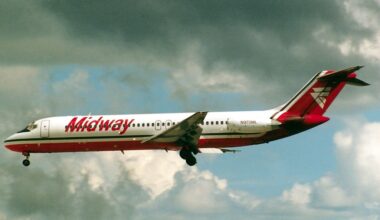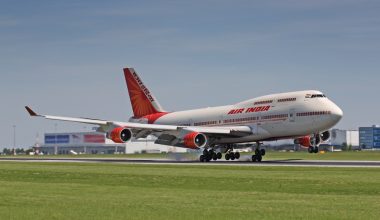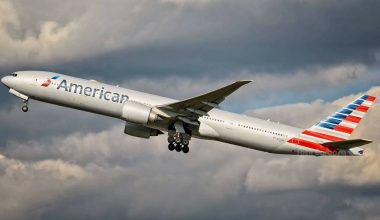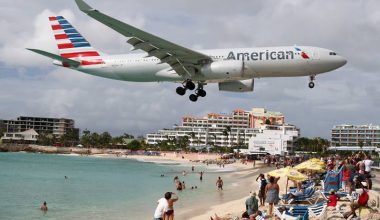Alaska Airlines is a SeaTac-headquartered US carrier that has been gracing the world skies since 1944. The carrier has progressively scaled up its operations to be the sixth-largest North American airline by fleet size and destinations served. Boeing 737 series aircraft form the backbone of Alaska’s fleet and play a crucial role in passenger-carrying operations. How many aircraft does Alaska Airlines have at present? Let’s take a detailed look into Alaska Airlines’ fleet in 2022.

Alaska Airlines fleet overview
With over 330 jets, Alaska Airlines boasts one of the largest aircraft fleets in the United States. It is a primary operator of Boeing 737 series aircraft, which includes third-generation derivatives -700s, -800s,-900s, -900ERs, and the latest-generation Max 9s. Besides, it also operates a handful of Airbus aircraft inherited from the acquisition of Virgin America in 2016.
Likewise, it has 11 single-class Dash 8-400s and 31Embraer 175s wearing the livery of its regional subsidiary Horizon Air. It has 42 other Embraer 175s, which are contracted to Skywest Airlines for regional operations.
Alaska Airlines’ fleet currently consists of the following:
- Boeing 737 series jets
- Airbus A320 narrow-bodies
- Embraer ERJ175
- De Havilland Canada Dash 8-400s turboprops
Now, let’s dig deep into each aircraft type in the Alaska Airlines fleet.
Boeing 737 series jets
Boeing 737 is the core of Alaska Airlines’ short and medium-haul operations. The mainline fleet of the Seattle-based carrier is mainly made of Boeing 737 variants. You can find the most widespread version of the previous 737 NG (-700,-800, -900s) and the latest-generation Max 9s in its fleet.

As of December 2022, Alaska Airlines has the following Boeing 737s variants in service
- 11 Boeing 737-700s
- 61 Boeing 737-800s
- 12 Boeing 737-900s
- 79 Boeing 737-900ERs
- 35 Boeing 737 Max 9s
The average age of Boeing 737s in the Alaska Airlines fleet is 10.2 years. Each 737 variant has a different seating capacity which is explained as follows:
Boeing 737-700s: 124 seats (12 in first class, 18 in premium cabin, and 94 in the main cabin)
Boeing 737-800s: 159 seats (12 in first class, 30 in premium cabin, and 117 in the main cabin)
Boeing 737-900s: 178 seats (16 in first class, 24 in premium cabin, and 138 in the main cabin)
Boeing 737-900ERs: 178 seats (16 in first class, 24 in premium cabin, and 138 in the main cabin)
Boeing 737 Max 9s: 178 seats (16 in first class, 24 in premium cabin, and 138 in the main cabin)
Airbus A320 family aircraft
At present, Alaska Airlines has sheltered two A320 family variants viz. A320-200s and A321neos in its wide fleet. The major US carrier was an all-Boeing 737 mainline fleet operator until it inherited Virgin America’s Airbus fleet in 2018. Alaska took possession of Airbus narrowbodies when the $4 billion transaction pushed Virgin America into its hands four years ago.
As of December 2022, 30 Airbus A320-200s and 10 Airbus A321neos are flying under Alaska Airline’s ensign. Both A320 family variants feature three-cabin configurations, i.e., first class, premium economy, and economy for Alaskan customers.

Alaska Airlines Airbus A320ceos can carry 150 passengers; 12 in first class, 24 in the premium cabin, and 114 in the main cabin. Likewise, the lengthened fuselage variant A321neos can accommodate 190 passengers; 16 first class, 24 premium, and 150 main cabin customers. The former aircraft, i.e., A320ceos, are nearly 13 years old on average. Meanwhile, A321neos are relatively young, with an average age of 4.8.
With a 3,700nm range, A320s serve Alaska’s domestic destinations like Las Vegas, Portland, OR, Los Angeles, San Francisco, Orange County, etc.
Alaska Airlines will sunset A320 narrow-bodies by 2023 as it drives toward a single fleet featuring Boeing aircraft. Despite the added capacity offered by A320s, Alaska has finalized its plans to retire A320s by the end of 2023.
De Havilland Canada Dash 8-400s
While Alaska Airlines’ mainline fleet consists of Boeing 737s and Airbus A320s, its regional fleet is composed of Dash 8-400s and Embraer 175s. The US legacy carrier has 11 Dash 8-400 regional turboprops flying under the Horizon Air brand. Horizon Air is a wholly-owned regional subsidiary of Alaska Air Group that serves over 40 US destinations.
Dash 8-400 bombardiers are powered by PW150A engines and fly at the cruise speed of 360knots. Alaska Airlines Dash 8-400s average 13.1 years and carry 76 passengers in a single-class configuration.
Like A320s, these turboprops are also set to enter their sunset years soon. The carrier will phase out Dash 8s next year in favor of twin-engine short-to-medium-range Embraer E175s.
Embraer 175s
Alaska Air has altogether 73 Embraer 175s, 31 of which are operated by Horizon Air and the rest operated by SkyWest Airlines. In contrast to single-class Dash 8s, E175s feature a three-class configuration with 76 all-leather, reclining seats. The first-class cabin accommodates 12 passengers featuring a single seat on one side of an aisle and two seats on the other.

Likewise, the premium and main cabin sections feature two seats on either side of the aisle and accommodate 12 and 52 passengers, respectively.
Fleet simplification strategy of Alaska Airlines
Alaska Airlines is accelerating its fleet simplification strategy with a firm commitment to exit the Airbus fleet by 2023. The carrier seeks to become an all-Boeing operator at the mainline level by phasing out A320-family aircraft. The fleet simplification strategy comes as the carrier plans to grow an average of 4-8% per year through the mid-decade. The transition of mainline operations to an all-737 narrowbody platform will result in operational simplicity, flexibility, and reduced maintenance costs for the carrier.
At the regional level, the carrier will stick completely with Embraer E-175s in conjunction with Horizon Air. The bombardier Dash Q-400s are not a part of Alaska’s long-term growth strategy and will retire by 2023.
In the coming years, Alaska Airlines will bid farewell to A320ceos, A321neos, and Dash Q-400s. It will transition its mainline fleet to B737 NGs and Maxs, building an efficient and sustainable fleet in the industry. Furthermore, it will solely hold on to Embraer 175 jets for regional flights at its subsidiary Horizon Air.
Upcoming Alaska Airlines fleet
To balance the number of retiring aircraft and continue its up-gauging strategy, new B737 models will join Alaska’s fleet. Alaska Airlines has bet big on Boeing and broadened its B737 Max portfolio to help meet its long-term growth strategy.
In October 2022, the mega-carrier exercised options to procure 52 B737 Max for delivery between 2024 and 2027. The move will result in the expansion of its confirmed 737 max fleets from 94 to 146. The carrier’s unfilled order book for 737 Maxs includes three different variants, i.e., 737 Max 8, Max 9, and Max 10s.
Alaska Airlines has outstanding orders for over 100 B737 Maxs to optimize its fleet growth through the next decades. The recent decision to add 52 Boeing aircraft is an endorsement of the Max family, its enhanced reliability, and improved fuel efficiency. The carrier is set to receive one new 737 Max every ten days in the next year.

The 162-seat Boeing Max 8 is slated to join the Alaska Airlines fleet in the second half of 2023. In line with its size, the American carrier will deploy Max 8s in medium-sized and high-yield routes. On the other hand, Boeing’s largest and most efficient single-aisle Max 10 is set to join the fleet in early 2024. Boeing 737 Max 10 will be Alaska’s most-efficient aircraft and provide further route flexibility and service to the carrier. It usually has a capacity of up to 189 passengers but can seat 204 passengers in a two-class configuration.
The only Max variant available in the Alaska fleet is Boeing 737 Max 9. With 35 jets already in service, the airline is set to receive 45 more Max 9s to operate high-demand core routes.
Shifting all-in on Boeing jets: Why?
Alaska Airlines’ shift to an all-Boeing narrowbody platform reflects the carrier’s commitment to creating a sustainable fleet in the industry. The single fleet featuring Boeing jets augments revenue opportunities for the carrier while reducing unit costs. The bulk-ordered Max family offers enhanced reliability and improved fuel efficiency for Alaska Airlines, with a 20% reduction in fuel use and CO2 compared to the aircraft it replaces. The carrier will benefit from the Max family’s latest technology which translates into unrivaled operational efficiency and environmental sustainability.
Alaska Airlines freighter fleet
While Alaska has firmly rooted its operations in passenger service, it also has a small share in the cargo sector. It has three active Boeing 737-700Fs to operate cargo flights and 2 Boeing 737-800Fs in order. The stretched freighter version of 737-700 will be delivered to the carrier starting next year.
About Alaska Airlines
Alaska Airlines is a Oneworld Alliance member operating mainly out of Seattle-Tacoma International Airport. With over 330 jets, the carrier flies to an extensive route network spanning more than 115 destinations worldwide. It has a remarkable presence in contagious United States, Belize, Canada, Costa Rica, and Mexico.






